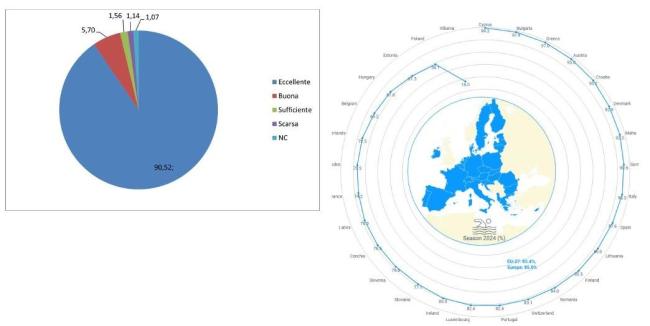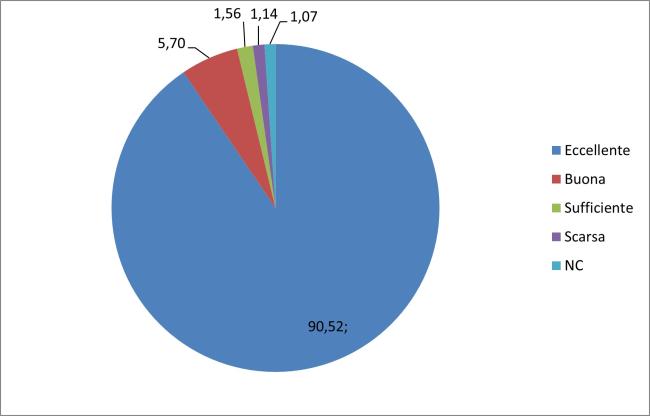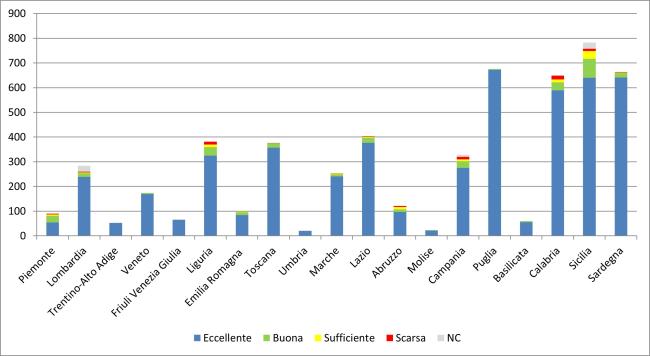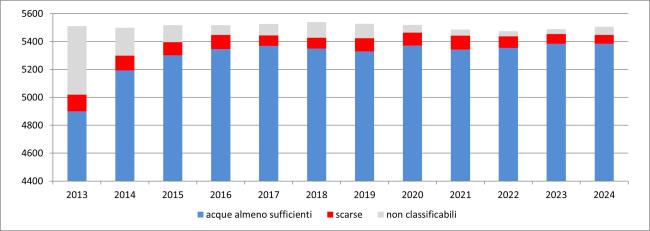Panel 1
Roberta De Angelis
The quality of bathing water is essential for the protection of the health of citizens and plays an important role also in terms of the protection of the natural environment and the economic aspects in the tourism sector. For this reason, specific monitoring is carried out throughout the bathing season. With regard to the bathing season 2024, more than 31,600 samples of seawater and lake were collected and analyzed on a total of over 5,000 km of bathing coast. At municipal level the km of coast are divided into more or less extensive bathing waters, for a total of 5,506 bathing waters. The results of the analysis, in addition to guaranteeing the absence of hygienic health risks during the season, have also allowed to classify the waters. The classification was made using the results of the monitoring carried out during the 2024 bathing season and those of the previous three seasons (2023-2022-2021). At the national level, most of the waters are excellent in the classroom (91%), however, however, there are still critical issues due to the presence of water in the low class (1.1%) and not classifiable (1.1%), for which it is not possible to make a quality judgment because most are newly identified and have not completed the 4-year cycle of monitoring, necessary for classification. Even at the regional level, the percentage of water in the excellent and good classes is the highest.
Directive 2006/7/EC on the management of bathing water quality, transposed in Italy with Legislative Decree 30 May 2008, n.116 and implemented by the Decree of the Ministry of Health 30 March 2010, provides that each water is assigned a quality class (excellent, good, sufficient and poor). The indicator shows the number of water falling within each class, at national and regional level, and is drawn up on the basis of "seasonal information" (Table 2, Annex F, DM 30 March 2010) which annually the Ministry of Health transmits to SINTAI pursuant to Article 6 of the Ministerial of DM 30 March 2010. For 2024, the data provided by the SNPA collected as part of the bathing activity line related to the thematic network of marine waters, marine-constier and transition (RRTEM-10) were also used. In the calculation of the quality status, in some cases the waters have been considered as groupings as a result of cases of contiguous waters with uniform characteristics (Article 7, paragraph 6, D.Lgs. 116/2008). This could lead to differences in the number of water between the different industry publications. It provides an orientational description of the quality of bathing water at the microbiological level, it does not, however, offer any indication of possible impacts from sources of pollution of other nature.
Assess the degree of bathability of a water associated with a sanitary risk and provide indications about the presence of microbiological contamination. In fact, on the one hand, it provides environmental indications of the level of microbiological contamination (faecal pathogens), on the other hand it expresses the probability of contracting a pathology associated with the aforementioned contamination during recreational activity (from excellent to poor class the probability increases). In addition, it allows an indirect estimate of the effectiveness of wastewater treatment systems and to assess over time the effectiveness of any remedial measures adopted. In fact, the legislation provides that improvement measures are put in place so that bathing water is at least of sufficient class and, in any case, every water can improve its quality status or maintain it if it is already excellent.
The indicator complies with the requirements of the European Directive 2006/7/EC, which provides for seasonal monitoring of bathing water and the classification of bathing waters, on the basis of monitoring data for 4 years. The aim of the directive is to no longer have waters in a low class and increase the number of those in the excellent class.
Panel 2
Sistema Informativo Nazionale per la Tutela delle Acque Italiane - http://www.sintai.isprambiente.it
Agenzia Europea dell'Ambiente - https://www.eea.europa.eu/themes/water/europes-seas-and-coasts/assessments/state-of-bathing-water/state-of-bathing-waters-in-2024
It offers an orientational description of the qualitative state of bathing water at the microbiological level, not providing, however, any indication of any possible impacts deriving from sources of pollution of other kinds.
Nessuna
Data quality assessment
SNPA e EEA
Used SNPA data collected as part of the Balneazione Activity Line pertaining to the thematic network RRTEM-10 and data of the European Environment Agency downloadable:
Acque di balneazione – SNPA – Sistema nazionale protezione ambiente
National, Regional
2013-2024
Indicator assessment
The indicator is developed by grouping bathing waters of each quality class at regional and national level. The classification is carried out on the basis of the monitoring results for the 2021, 2022, 2023 and 2024 campaigns.
As shown in Figure 1, at national level, the percentage of excellent quality water is high compared to the European average (90% versus 85% in the EU). At regional level (Figure 2), and in general, it can be said that the number of waters in excellent and good class is very high in all regions, however, the presence of scarce water in 11 regions prevents the total achievement of the objective of the directive.
As shown in Figure 3, the trend is positive until 2017, as water in poor classroom decreases and higher quality waters increase, especially excellent and good. From 2017 to 2019 there is a reversal: the waters in excellent class are reduced and those in the low class increase. In 2020, there is a slight improvement: in fact, water in a poor class returns to decrease while those of upper class, in particular excellent, increase. In 2024, the trend of improvement due to the increase in the number of water in good and excellent class and to the decrease in water in poor and non-classifiable classes, demonstrating that the latter category of water often contains waters of higher quality and not necessarily poor.




During the 2024 bathing season in Italy, 5,506 bathing waters were classified: 4,984 belong to the excellent class, 314 to the good class, 86 to the sufficient class and 63 to the poor. The number of unclassified waters is 59 and for many of these it is not possible to make any evaluation because they are of new designation and have not completed the four-year period necessary for classification. In all regions, the number of excellent water is higher than the other classes and if you add up the waters in good class this value exceeds 90% (Figure 2). The waters in poor class are present in variable numbers in the following regions: Piedmont, Lombardy, Liguria, Tuscany, Marche, Lazio, Abruzzo, Campania, Calabria, Sicily, Sardinia. They are still present in some regions non-classifiable waters for which it has not been possible to express a quality judgment for various reasons, mainly because they are newly identified waters and have not reached the minimum number of samples useful for classifying. In some cases, from one season to the next, there may be a worsening of the qualitative state of a bathing water that can be attributed to several factors, including the effectiveness of purification systems and sewage systems also in relation to climatic conditions. In fact, the monitoring of bathing water evaluates the presence of fecal contamination, deriving mainly from urban discharges. When factors involve compromising their effectiveness, such as failures or intense rain events, these systems release untreated wastewater into the environment, which impair bathing. An example of this are the heavy rains that have occurred in recent seasons, as they have sent several purifiers into a tailspin, resulting in unpurified wastewater discharge. Unfortunately, these events remove the achievement of the directive’s objective and draw attention to better management of the territory to which bathing water belongs, also in function of climate change. In general, the monitoring results performed during season 2024 showed a slight improvement, due to the maintenance of the high number of water in excellent and good class and a decrease in the number of low-class water.